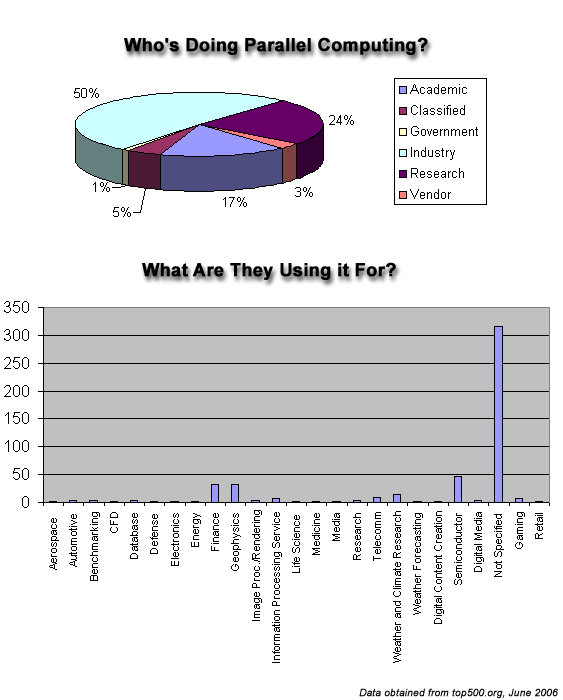CSC/ECE 506 Fall 2007/wiki1 2 sk: Difference between revisions
No edit summary |
No edit summary |
||
| Line 1: | Line 1: | ||
===Topic for | ===Topic for Discussion=== | ||
Section 1.1.1, second half: Commercial application trend | Section 1.1.1, second half: Commercial application trend | ||
| Line 8: | Line 8: | ||
==Overview== | ==Overview== | ||
Parallel Computer | |||
Parallel Computer Architecture has been an active research area for almost 40 years and commercial parallel computers have been available for more than 35 years. After getting off to a slow start, this area has now taken off. Shared memory multiprocessors have dominated this development. This is an area that has sprung out of tireless research and numerous published breakthrough results. | |||
The degree of parallelism in case of commercial applications is not as high as in scientific applications. But, use of parallel computing in commercial application is even more wide spread. | |||
Transaction Processing Performance Council has setup benchmarks that measure the performance of a system in terms of | |||
Applications in Engineering and Design | Applications in Engineering and Design | ||
| Line 29: | Line 34: | ||
Applications in Computer Systems | Applications in Computer Systems | ||
* Network intrusion detection, cryptography,multiparty computations | * Network intrusion detection, cryptography, multiparty computations | ||
are some of the core users of parallel computing techniques. | are some of the core users of parallel computing techniques. | ||
* Embedded systems increasingly rely on distributed control | * Embedded systems increasingly rely on distributed control | ||
Revision as of 18:55, 5 September 2007
Topic for Discussion
Section 1.1.1, second half: Commercial application trend
- What characterizes present-day applications?
- How much memory, processor time, etc.?
- How high is the speedup?
Overview
Parallel Computer Architecture has been an active research area for almost 40 years and commercial parallel computers have been available for more than 35 years. After getting off to a slow start, this area has now taken off. Shared memory multiprocessors have dominated this development. This is an area that has sprung out of tireless research and numerous published breakthrough results.
The degree of parallelism in case of commercial applications is not as high as in scientific applications. But, use of parallel computing in commercial application is even more wide spread.
Transaction Processing Performance Council has setup benchmarks that measure the performance of a system in terms of
Applications in Engineering and Design
- Design of airfoils (optimizing lift, drag, stability), internal
combustion engines (optimizing charge distribution, burn), high-speed circuits (layouts for delays and capacitive and inductive effects), and structures (optimizing structural integrity, design parameters, cost, etc.).
- Design and simulation of micro- and nano-scale systems.
- Process optimization, operations research
Commercial Applications
- Some of the largest parallel computers power the wall street!
- Data mining and analysis for optimizing business and marketing
decisions.
- Large scale servers (mail and web servers) are often
implemented using parallel platforms.
- Applications such as information retrieval and search are
typically powered by large clusters.
Applications in Computer Systems
- Network intrusion detection, cryptography, multiparty computations
are some of the core users of parallel computing techniques.
- Embedded systems increasingly rely on distributed control
algorithms.
- A modern automobile consists of tens of processors communicating
to perform complex tasks for optimizing handling and performance.
- Conventional structured peer-to-peer networks impose overlay
networks and utilize algorithms directly from parallel computing.
